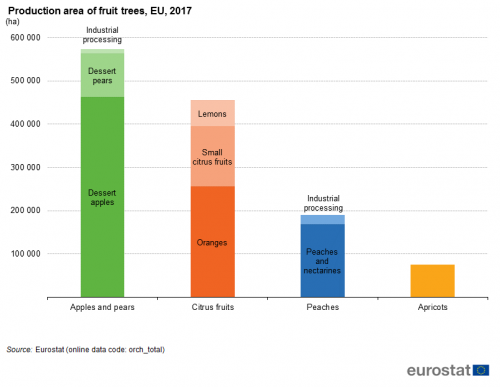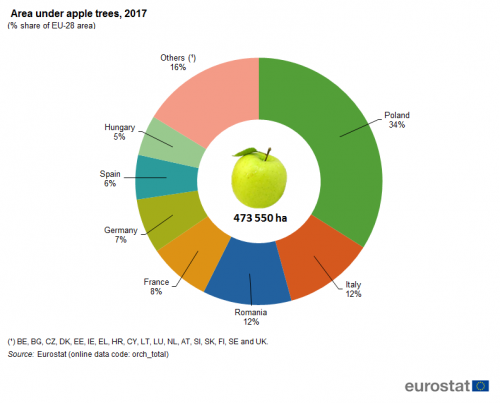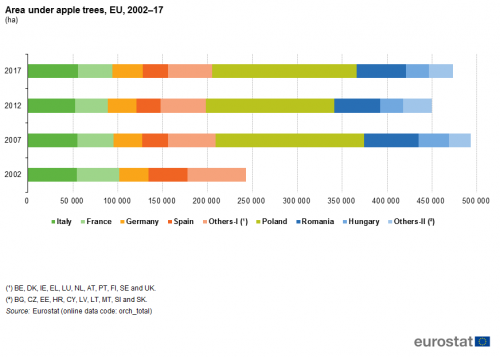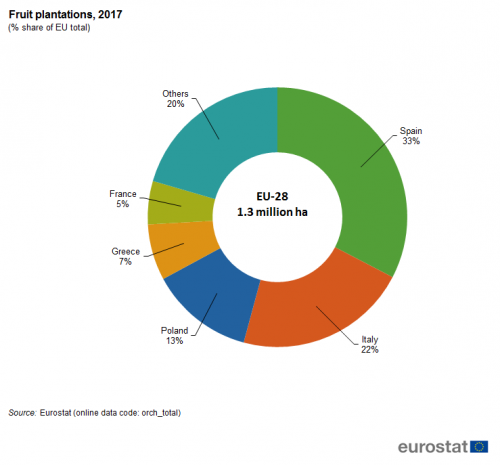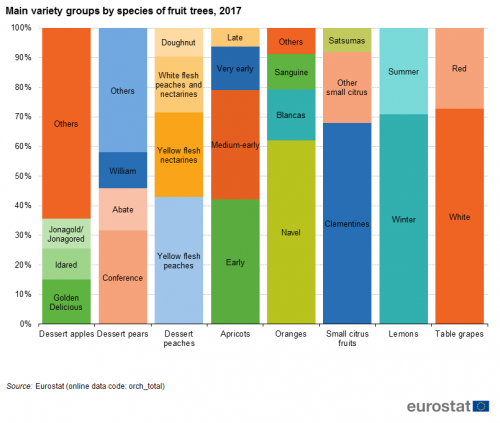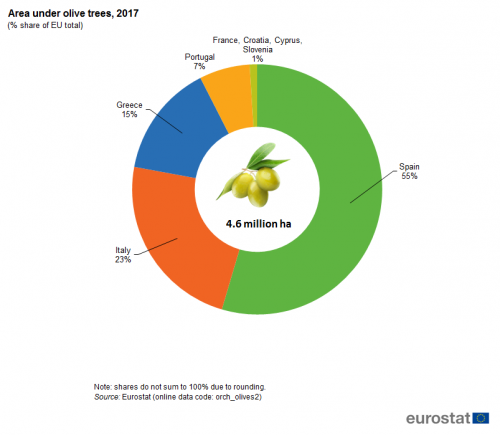Agricultural production - orchards
Data extracted in January 2019.
Planned article update: June 2025.
Highlights
This article reports on the structural aspects of permanent crops which are collected in surveys every 5 years. It provides a complement to the articles that refer to annual production data. The reference year for the latest collection of orchards data is 2017. The species surveyed are apple trees, pear trees, apricot trees, peach trees, orange trees, small-citrus fruit trees, lemon trees, olive trees and, on voluntary basis, vines producing grapes for table use.
Full article
General overview
The seven fruit and citrus fruit species assessed in the 2017 orchard survey covered an area of 1.295 million hectares (ha) across the EU, some 5 700 ha (or +0.4 %) more than was recorded in the 2012 survey.
A little over one third (36.6 %) of the total area of fruit plantations in the EU was represented by apple orchards, and another one fifth (19.7 %) by orange groves. Of the remainder, peach and nectarine orchards covered a further 14.7 %, small citrus fruit trees producing satsumas and clementines in particular 10.8 %, pear trees 7.7 %, apricots 5.8 % and lemon groves a further 4.6 % (Figure 3b). The share of different fruit and citrus fruit species was fairly stable between 2012 and 2017.
Spain accounted for about one third (32.6 %) of the EU's fruit plantations in 2017 (Figure 3). Another one third of the EU's fruit plantations was together found in Italy (21.6 %) and Poland (12.9 %), a country which has specialised in apple production.
Apple trees
Apple orchards in the EU covered 473 500 ha in 2017. About one third (34.0 %) of the area devoted to apple orchards in the EU was found in Poland (160 800 ha) in 2017, with a further one quarter split evenly between Italy and Romania (55 800 ha and 55 100 ha respectively). Together with France (8.1 % of the EU total), Germany (7.2 %), Spain (5.8 %) and Hungary (5.3 %), these seven EU Member States accounted for more than two-fifths (83.7 %) of the total EU area under apple trees (Figure 1).
Apple orchards in the EU expanded by 23 900 ha between 2012 and 2017 (see Figure 2), with most of that expansion concentrated in Poland (+17 700 ha, or +12 %), Romania (+3 800 ha or +12 %) and Italy (+3 600 ha, or +7 %). There were some notable reductions, however, in Czechia ( 2 700 ha, or -24 %) and Slovakia (-1 500 ha, or -39 %).
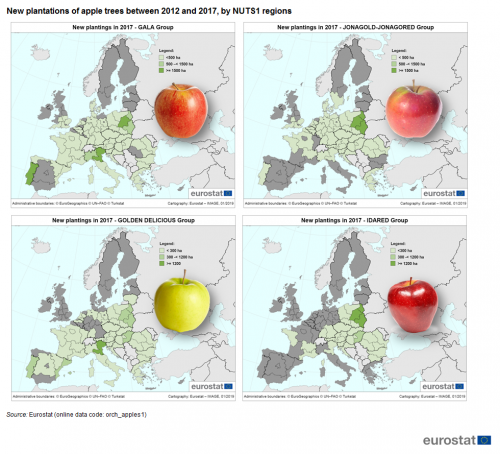
New plantations of apple trees
Gala and Jonagold/Jonagored were the most popular choice of newly planted apple tree varieties between 2012 and 2017 (each accounting for 14 % of the area of newly planted orchards), followed by Golden Delicious (10 %) and Idared (8 %). The popularity of tree varieties in new plantations was different in the EU regions: new Gala plantations were localised in Eastern Poland, Northern Italy and Portugal; Jonagold/Jonagored in Eastern Poland; Golden Delicious in North-East Italy mainly, plus in Eastern Spain, Portugal, Eastern Hungary and Eastern Poland; and, new Idared plantations mainly in Eastern Poland and Eastern Hungary (Figure 2b).
Other fruit trees
Spain, Italy and Greece are the EU’s largest citrus fruit (oranges, small citrus fruits and lemons) producing countries. There were 455 000 ha of citrus fruit plantations across the EU in 2017, of which Spain accounted for 60 %, Italy 27 % and Greece 9 %. Orange groves accounted for a little over one half (56 %) of citrus fruit plantations in the EU, small citrus fruits groves a further one third (31 %) and lemons the rest (13 %) (Figure 4).
Orchards of peaches (including nectarines) covered 190 500 ha in the EU in 2017 (Figure 3b). Spain accounted for two-fifths (41 %) of the EU total, with Italy and Greece having the next largest peach orchards (Table 1).
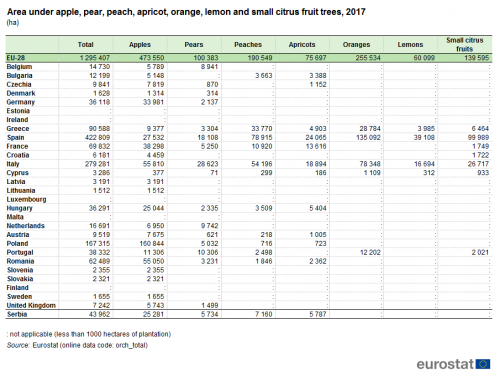
(ha)
Source: Eurostat (orch_total)
The area under pear trees in the EU covered 100 400 ha in 2017 and was distributed more evenly among Member States than many other fruit varieties due to its suitability for more varied climatic conditions. Nevertheless, about one half (47 %) of the EU total area was concentrated in Italy and Spain, with Portugal, Belgium and the Netherlands each accounting for about a further 10 % of the EU total.
Apricot trees grew on almost 76 000 ha across the EU in 2017, the majority being found in Spain (32 %), Italy (25 %) and France (18 %) (Table 1). Between 2012 and 2017, there was an increase of 8 100 ha (12 %) in the area of EU apricot plantations.
Main fruit varieties
There are strong preferences for the planting of varieties or groups of varieties of some fruit in the EU, and a much broader planting of varieties or groups of varieties of other fruit. In the EU, “navel oranges” accounted for approaching two-thirds (62 %) of orange tree varieties in 2017 and clementines accounted for a little over two-thirds (68 %) of small citrus fruit trees (Figure 4). The most represented variety groups of other tree fruit in 2017 were “yellow flesh peaches” (43 %), “early” apricots (42 %), and “conference” pears (32 %). There was arguably more variety in apple trees, with “Golden Delicious” being the most widespread (but with only 15 % of the EU’s total apple area), followed by Idared and Jonagold/Jonagored (both 10 %). Over 60 % of apple orchards and 40 % of pear orchards were covered by ‘Other’ variety groups. In the case of the former, it should be noted that there is no variety group information available for approximately 14 000 ha of the apple orchards.
Olive trees
The area under olive trees accounted for about 4.59 million ha in the EU in 2017, which was concentrated in the area around the Mediterranean. Eight EU Member States had olive tree areas that exceeded 1 000 ha (the threshold for the orchard survey). Spain (55 %) and Italy (23 %) accounted for over three-quarters of the total EU area under olive trees (see Figure 5). They were followed by Greece and Portugal with 15 % and 7 % of the total EU area under olive trees respectively. The other olive producing Member States (France, Croatia, Cyprus and Slovenia) each accounted for a small share of the EU total olive tree area (together about 1 %).
Olive trees are very resistant to drought, diseases and fire. They are known for their longevity. Most of the EU's olive trees are old. Nearly 2.5 million ha are planted with olive trees that are at least 50 years old and almost 1.7 million ha with trees that are 12–49 years old. More newly planted areas are less common; there were 281 000 ha that were between 5 and 11 years old in 2017 and about 176 000 ha that were less than 5 years old and planted since the previous orchards survey (Figure 6).
The least densely planted olive groves (less than 140 trees per ha) covered 46 % of the total area in 2017 (Figure 7). Another 48 % was covered by plantations with 140 to 399 trees per ha, with the remaining 5 % of the area planted with a density of at least 400 trees per hectare.
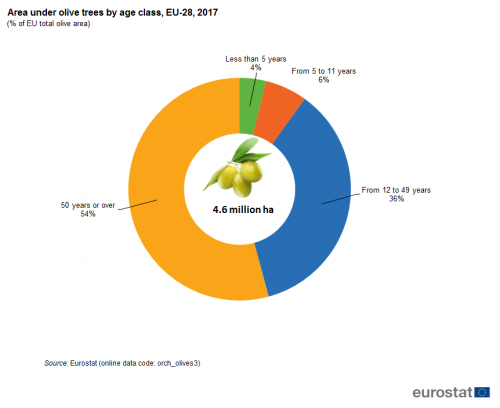
(% of EU total olive area)
Source: Eurostat (orch_olives1)
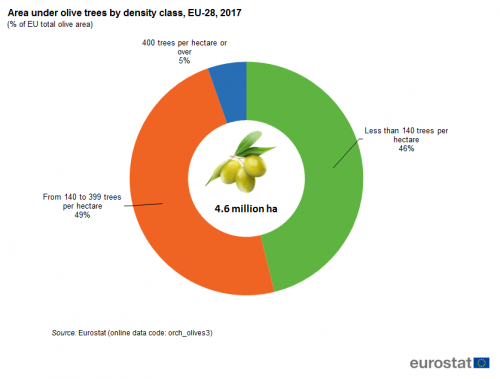
(% of EU total olive area)
Source: Eurostat (orch_olives2)
Vines producing table grapes
Data on table grapes are available for Spain, Bulgaria, Italy and Romania. Italy had by far the largest area (39 700 ha) dedicated to table grapes, followed by Spain (about 12 500 ha), Romania (about 5 200 ha) and then Bulgaria (about 2 700 ha).
In all of these table grapeing countries more than one half of the table grape area was densely planted (with more than 1 500 vines/ha) (Figure 8).
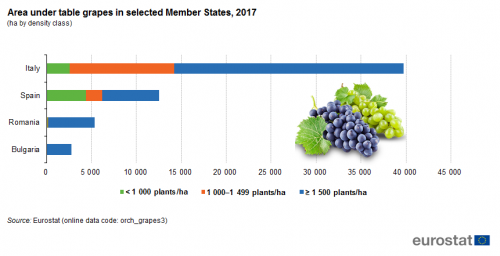
(ha by density class)
Source: Eurostat (orch_grapes2)
Source data for tables and graphs
Data sources
The orchard domain (orch) contains the results of the structural fruit tree surveys (apples, pears, peaches (including nectarines), apricots, oranges, lemons, small citrus fruits, and since 2012, olives and vines intended for the production of table grapes). In the orchard survey, data on the areas are collected (in hectares) by variety, age and density classes, by country and by NUTS 1 regions. Data are mainly grouped in tables by fruit tree species.
The statistical surveys on orchard area are carried out every five years by the EU Member States in order to determine the production potential of plantations of certain species of fruit trees. These surveys have been carried out since 1977. In accordance with Regulation (EU) No 1337/2011, the last Orchard survey was carried out for the reference year 2017.
The survey includes all areas intended to produce for the market even those which are not yet in production. The total survey area deviates from the area of the Member State orchards registered in the annual crop statistics, where only areas in production are covered.
Context
There is a diverse range of natural environments, climates and farming practices across the European Union (EU), reflected in the broad array of food and drink products that are made available for human consumption and animal feed, as well as a range of inputs for non-food processes. Indeed, agricultural products form a major part of the cultural identity of the EU’s people and its regions.
Statistics on agricultural products may be used to analyse developments within agricultural markets in order to help distinguish between cycles and changing production patterns; they can also be used to study how markets respond to policy actions. Agricultural product data also provide supply-side information, furthering understanding as regards price developments which are of particular interest to agricultural commodity traders and policy analysts.
Direct access to
- Other sub-national statistics (reg_nat)
- Orchard statistics by production region (reg_orch)
- Agriculture, forestry and fisheries, see:
- Agriculture (agri)
- Structure of orchards and vineyards (orch_vit)
- Orchard (orch)
- Structure of orchards and vineyards (orch_vit)
- Agriculture, forestry and fishery statistics — 2018 edition (Statistical book)
- Orchard (ESMS metadata file — orch_esms)
- Regulation (EU) No 1337/2011 of 13 December 2011 concerning European statistics on permanent crops
- Summaries of EU Legislation: Production of EU statistics for permanent crops
- Summaries of EU Legislation: EU integrated farm statistics
